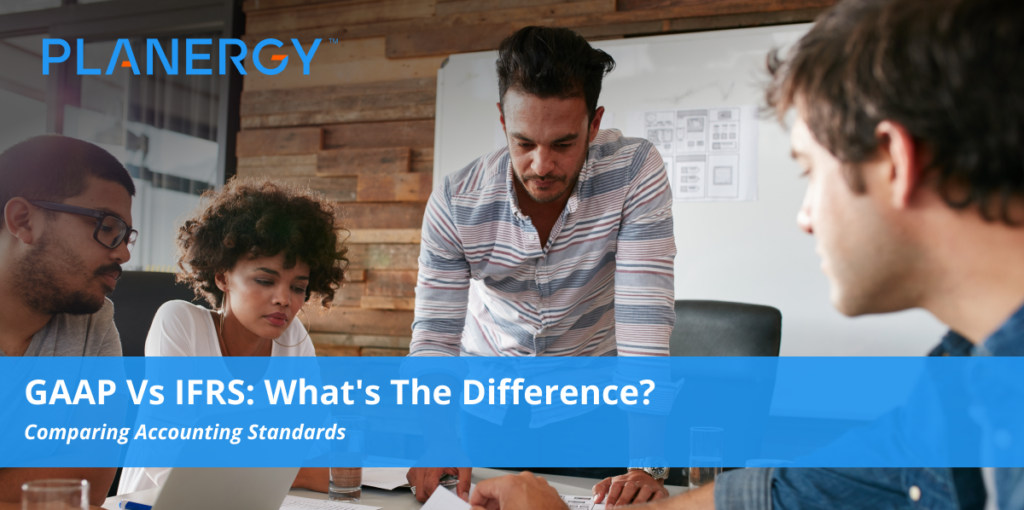When it comes to GAAP vs. IFRS, you’re comparing two accounting standards, which outline the principles countries all over the world follow when it comes to financial reporting.
GAAP stands for Generally Accepted Accounting Principles. They were created by the Financial Accounting Standards Board to support public companies in the United States when creating their annual financial statements.
Only US companies use GAAP. This set of principles must be followed when preparing annual financial statements.
This method ensures there is no inconsistency in the financial statements public companies submit to the U.S. Securities and Exchange Commission (SEC).
This allows investors to directly compare the financial statements of numerous publicly-traded companies to make informed decisions about their investments.
IFRS, on the other hand, stands for International Financial Reporting Standards, which sets the international standards participating countries should follow.
More than 110 countries worldwide use this approach, in an effort to create uniform financial statements. It refers to a set of standards that governs how companies around the world prepare their financial statements.
The standards do not dictate exactly how financial statements need to be prepared but instead provides guidelines that make the accounting process standard across the world.
Some of the areas that use IFRS are the European Union, South America, parts of Africa, and parts of Asia.
There are some major differences between the two sets of accounting standards that CPAs need to be aware of.
Key Differences Between GAAP vs. IFRS
How Inventory is Treated
When it comes to inventory costs, the two accounting standards treat them differently. Following the IFRS standards does not allow for the use of LIFO, or last-in, first-out method of calculating inventory.
Under GAAP, however, businesses can use either LIFO or FIFO, or first-in, first-out method to estimate inventory.
The IFRS approach doesn’t allow for LIFO because it doesn’t demonstrate the flow of inventory and may represent lower levels of income than is actually the case.
The flexibility to use either FIFO or LIFO under GAAP, however, allows organizations to choose the method that is most convenient when valuing their inventory.
Inventory Reversal
Beyond having different inventory tracking methods, IFRS and GAAP also differ in how reversals are handled. GAAP specifies that if the market value of the asset increases, the write-down cannot be reversed.
With IFRS, however, you can reverse the write-down. GAAP is overly-cautious of inventory reversal and doesn’t reflect positive changes in the marketplace.
How Fixed Assets Are Treated
Under GAAP with fixed assets such as furniture, equipment, and property, organizations must value these assets with the cost model.
The cost model considers the historical value of an asset minus any accumulated depreciation.
Under IFRS, fixed assets are valued under the revaluation model which is based on Fair Value at the current date minus any accumulated depreciation and impairment losses.
How Intangible Assets are Treated
Under GAAP, intangible assets are recognized at their current fair market value and no additional future considerations are made.
Under IFRS, the intangible assets are only recognized if they will have any future economic benefit. With this approach, the asset can be assessed and given a monetary value.
Rules vs. Principles
A major distinction between the GAAP and IFRS is and how they affect the accounting processes.
Under GAAP, the accounting process is highly specific, rule and procedure-based.
This method leaves little room for interpretation she prevents opportunistic entities from creating exceptions in an effort to maximize their profits.
With the IFRS, it is a principle-based approach that provides guidance for companies to follow and interpret to the best of their judgment.
Businesses enjoy some flexibility to make different interpretations of the same situation
How Revenue is Recognized
Under GAAP, the process begins by determining whether the revenue has been realized or earned.
From there, it has specific rules on how revenue recognition occurs across various Industries.
The guiding principle is the revenue isn’t recognized until the exchange of a good or service is complete. Once a good has been exchanged in the transaction recognized and recorded, the accountant has to consider the specific rules of the industry in which the business operates.
With IFRS, revenue is recognized when the value is delivered. It groups all transactions of revenues into four categories: the sale of goods, construction contracts, provisions of services, or use of another entities assets.
Companies that use IFRS accounting standards use the two following methods of recognizing revenue: They recognize revenues as the cost that can be recovered during the reporting period.
When it comes to contracts, revenue is recognized based on the percentage of the whole contract that has been completed along with the estimated cost, and the value of the contract.
Recognized revenues should be equal to the percentage of work that has been completed. In other words, revenue with long-term contracts will equal cost.
How Liabilities are Classified
When preparing financial statements based on the GAAP accounting standards, liabilities fall either into current or non-current liabilities, depending on the amount of time allotted for the company to repay the debt.
That’s that the company expects to repay within the next 12 months are considered current liabilities.
Debts with a repayment period that exceeds 12 months, however, are classified as long-term liabilities.
Following the IFRS accounting standard, there is no distinction between liabilities so both short-term and long-term liabilities are grouped together.
Development Costs
Using IFRS, a company’s developer costs can be capitalized as long as certain criteria are met. With this approach, businesses can leverage depreciation on their fixed assets. With GAAP, however, the development costs have to be expensed the year they occur, and cannot be capitalized.
Income Statements
Under GAAP, unusual or extraordinary items are separated and displayed below the net income portion of the income statement.
Under IFRS, however, the items are included in the income statement and not separated.
Capitalization of Interest Costs
Under IFRS, interest on short-term loans are offset against capitalized costs. These offsets are not allowed under GAAP.
Quality Characteristics
Another difference to consider between the two accounting standards is how the methods function.
GAAP works within a hierarchy of characteristics including comparability, relevance, understandability, and reliability, so it’s possible to make informed decisions based on user-specific circumstances.
IFRS works under the same characteristics, but the decisions cannot be made on the specific individual circumstances.
It is crucial to understand the significant differences between GAAP vs IFRS accounting, especially if your company plans to conduct business internationally.
As a U.S-based company, you must abide by the specific accounting regulations as set forth by GAAP, even if you plan to conduct international business.
Financial reporting helps to facilitate comparison between companies to provide both cross-sectional time-series analysis. Good financial reporting seeks to give sufficient financial information about the reporting entity so it is useful to lenders, potential investors, creditors, stakeholders, etc.
Because of this, standard-setting bodies set out to provide comprehensive and transparent financial statement presentations. Otherwise, corporate finance would become even more complicated than it already is.
Though efforts to converge the two standards and how financial information is reported are underway, financial analysts must be cautious about the differences when attempting to analyze financial reports.
The frameworks do go a long way toward setting up standards in keeping financial reporting consistent regardless of which accounting system is used.




